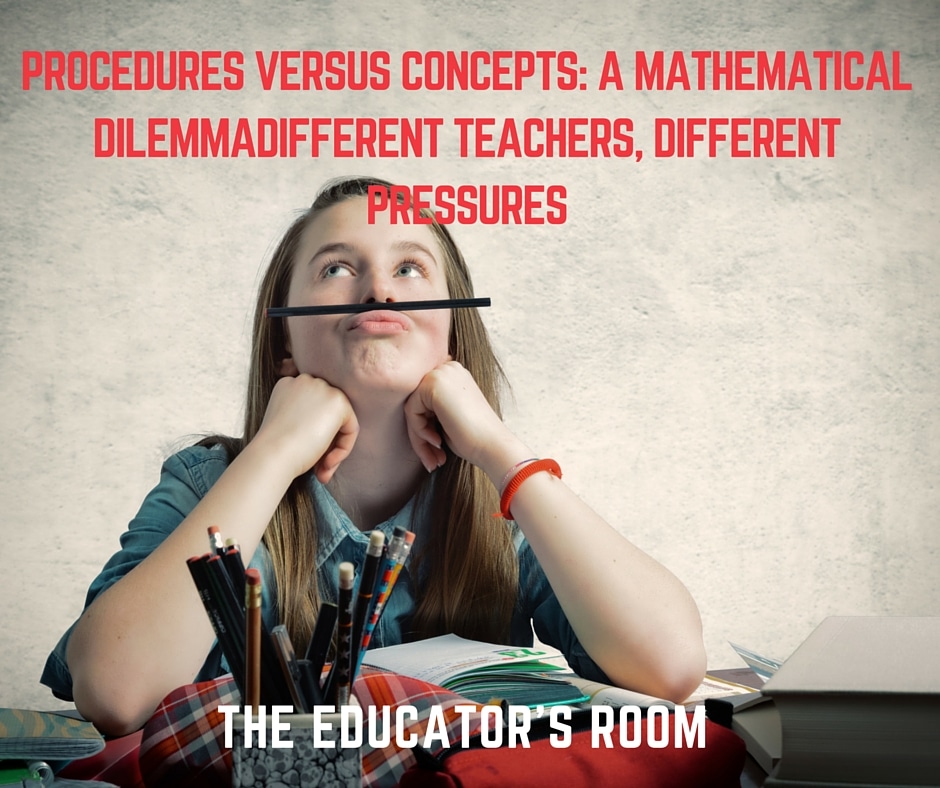There have been a lot of articles lately debating procedural teaching and concepts-based teaching in the classroom. As an elementary school teacher, this topic is of particular interest as mathematical reform models are sweeping through our curriculum. Whether you are a Common Core Standards state or, as in Virginia, simply “aligned” with Common Core, mathematical reformists argue that teaching the way of the past simply does not work for our students of today. The old “drill and kill” model, reformists argue, simply do not teach our students what math means in order to partake in higher level student discourse. On the other hand, traditionalists argue that one of the reasons for the slow improvement in mathematical education in the US is the fact that procedural based teaching is almost taboo in today’s classroom. Meanwhile, intermediate and middle school math teachers are wondering why their students still do not know their basic facts. So what do we do?
I argue that a healthy dose of procedural based instruction mixed with conceptual based learning is what is needed in the mathematics classroom. When teaching basic facts, our students should be able to discuss that repeated addition is the same as multiplication. They should be able to tell us that 5 x 4 = 20 because 5 + 5 +5 +5 = 20. They should be able to draw an array and other representations that depict this equation and even discern a multiplication word problem over an addition word problem because they have identified the word “product” or “factors” over “addends” or “altogether.” However, when students are asked to multiply 1,245 x 623, do we really expect them to draw a picture? Do we want them to add 1,245 over and over until they have done it 623 times? Hopefully your answer is a resounding NO! This is where the procedural teaching takes place. Despite the fact that in the “real world” we would simply take out our iPhones and open the calculator application to solve this problem, our students for some strange reason are asked to do this by hand. We can teach them lattice multiplication, area model multiplication, or even Egyptian multiplication style of halving and doubling if you like. At the end of the day, these are all procedural methods to help the students actually solve the conceptual problem.
This seems like a rather simple and mundane answer to a relatively simple issue. The problem is, reformists argue that concepts based mathematics should come before procedural based teaching. In fact, this is the dominant point of view in the state of mathematics. States have designed their curricula around it, textbooks are written for it (see Mathematical Inquiry) and administrators are looking for it when they come into the classroom.
For math teachers, all of this creates a sort of cognitive dissonance. They know what needs to be done, but are worried about being caught teaching procedurally. Let me make a medical parallel here for a minute since that is often how educators like to compare their profession. Teaching concepts before procedure or in lieu of procedure is like a doctor knowing where a heart is located, why it beats and how it beats, but has no idea how to perform heart surgery. I don’t know about you, but I would rather have a doctor that knows how to perform heart surgery but doesn’t know how a heart beats than the other away around. Although having one that knows both would give me the greatest confidence in their abilities.
Stephen Wilson, a math professor at John Hopkins University, recently stated “the way mathematicians learn is to learn how to do it first and then figure out how it works later,” at a conference held in Winnipeg. (Thank you Barry Garelick, writer for Education News for this information). To the chagrin of most of his colleagues, Stephen Wilson is echoing what many teachers are feeling in the classroom. We understand that concepts are important and that high-level questioning and open-ended responses will create a well-rounded young mathematician. What we also understand, however, is that unless they know how to do the math, that the concepts will simply become abstract ideas that are grounded in nothing.
What this means for the mathematics teacher is that we must be confident in our abilities. We must understand both the content and the pedagogy behind mathematics so that we can speak to what we are doing and why we are doing it in the classroom. We should be able to explain to our administrators why we are teaching procedurally to one group of students while others are grounded in concepts, number sense and theory. All educators understand that a single initiative for any content area will not be the panacea, but rather taking resources from a variety of areas to meet the diverse and unique needs of our students is the best way to reach them. Whether you believe in concepts or procedures, my argument is to believe in both.







Step by Step procedure with lots of practice problems for those who need as well as those who want them. Practice still does make perfect.
I would hope that any doctor who started performing heart surgery procedure before s/he knew "where a heart is located, why it beats, and how it beats" wasn't allowed near any live patients, as the idea that anyone would be any good at it without background information is absurd.
A surgeon who was simply taught the heart surgery procedure would be fine as long as conditions were the same in surgery as they were during training. However, when a heart came around that was different, with no background knowledge to fall back on, s/he would be paralyzed by indecision, much like our students when they encounter a problem that's different from the examples they saw in class.
Providing a strong conceptual framework ensures that students will be able to flexibly apply their knowledge to any situation, not just those for which they have seen examples, in the same way that heart surgeons can operate on any heart given their general knowledge.
However, in the same way that we would not give heart surgeons a book course and then send them off to do surgery, we should not simply help students develop conceptual knowledge and then expect them to easily apply it. Procedures do have a place in mathematics instruction. Where the old drill-and-kill went awry is de-contextualized procedures; they need to be developed hand-in-hand with the concepts. Unfortunately, many mathematics courses teach only procedures, with the expectation that the concepts will be magically derived from those procedures, and it just doesn't happen.
This discussion reminds me of what the late comedian (and before that, high school math teachers) Sam Levinson used in one of his routines. He was describing the New Math as follows:
"When I was a kid, we learned on Monday that 6 + 8 is 14, on Tuesday that 8 + 6 is 14, and we fiigured that it was a coincidence. Nowadays, every kid can tell you that 6 + 8 equals 8 + 6 because of the commutative law, but they think that the answer is 17."
I am a mathematics professor at a four-year college in CUNY, the City University of New York. The NYC Department of Education brags that the percentage of NYC high school graduates deemed college-ready by CUNY has increased from 18% to 24% in recent years. Unfortunately, a huge percentage of so-called "college-ready" students cannot do basic mathematics, such as converting 3/8 to a decimal.
Analogies are dangerous. There is no connection between heart surgery and elementary mathematics. The former is an immensely complex enterprise that did not exist a century ago. The latter has been around for thousands of years and depends only on shared everyday activitiesWell before the word "commutative" was coined, people knew why you can reverse the order of multiplication and get the same answer. If that's what's called a concept, fine: explain it for five minutes and then get down to the business of teaching the times tables.
Ultimately, the basic issue is that professors of math education want to be viewed as deep thinkers about mathematics. The idea that children can and should be taught to be deep thinkers about mathematics is a necessary consequence of this position.
Dr. Championa0a0I see a huge problem with our coellge students using the solution manuals to copy their homework, but they are just copying the equations and steps down, not linking what they are seeing to the concepts of the topics covered in their classes. I haved tried to play devil’s advocate with the students who are doing this, but to no avail. They don’t want to hear comments from me, just finish their homework so they can leave and do things fun for the rest of the day!!
What is wrong with both? Kids are sponges– give them a healthy dose of drill and wide exposure to concepts. They will find their pathway to mathematical literacy.
Glad you were able to use the Stephen Wilson quote! You might be interested in another article I recently wrote on the current state of math ed in the US, at the online Atlantic:
http://www.theatlantic.com/national/archive/2012/…
Great article!
Excellent article and comments! Here is a link to a new math study which I highly recommend everyone read: http://www.psychologicalscience.org/index.php/new…
WOW! This is an awesome serach engine. I randomly typed in some equations as well as function rules and actually got some valuable information back. Students can use this site to gain more clarification and or insigt into the math that I am trying to teach them about. Sometimes I get brain-farts about specific concepts that I have not used in a while. So, I too can use this site to get more clarity on concepts.
I am now a firm believer that students should know how to add, subtract, multiply, and divide fluently. Once this happens, making connections becomes dramatically easier and those struggling students gain math confidence instead of math anxiety.